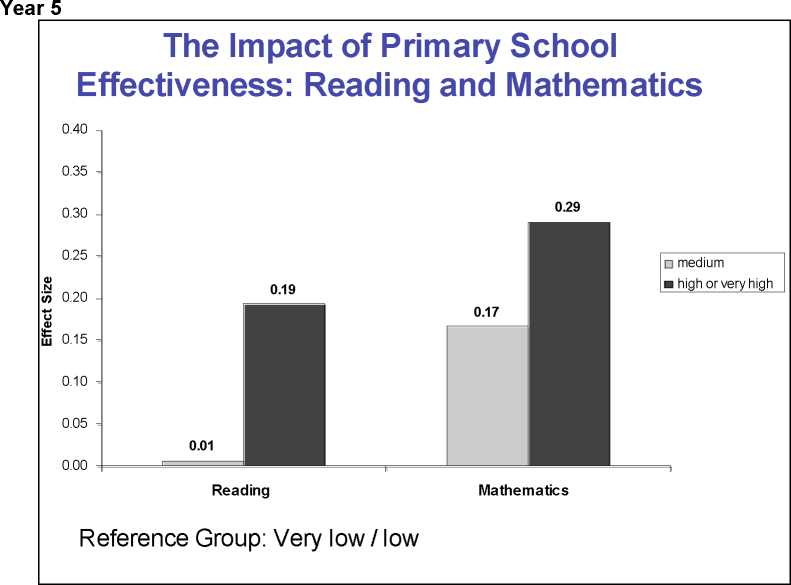who had gone on to attend a high or very highly effective primary school in promoting English
also have better Reading attainment at the end of Year 5 than children who had attended a low
effective primary school.7
Figure 3.7: The net impact of primary school effectiveness on cognitive outcomes at

Different influences of primary school effectiveness for different groups of
children
We explored any differential influences of primary school academic effectiveness on children’s
cognitive attainments at Year 5. Two measures of disadvantage were examined: 1) the multiple
disadvantage index and; 2) the highest qualification level of the parents. These analyses were
based on the reported models and control for all other background factors found to have a
significant impact on attainment. The multiple disadvantage index is a summary measure based
on various child, family and HLE predictors that are associated with an increased risk of low
attainment in pre-school and Key Stage 1 (see Glossary for details).
1. Multiple disadvantage and the impact of primary school effectiveness
The sample was divided into two groups, representing less and more disadvantaged children.
For attainment in Reading the academic effectiveness of the primary school (measured
independently by value-added analyses) in English is relatively more important for the
disadvantaged than for the less disadvantaged children. Compared to a low effective primary
school, disadvantaged children show higher attainment when they go to a highly effective
primary school (ES = 0.25) but not if they attend a medium effective school (ES = -0.05). By
contrast, for less disadvantaged children there seems to be no difference whether they go to a
medium effective (ES = -0.03) or to a high effective (ES = -0.03) school compared to a low
effective one.
7 It is important to note that attainment in Reading and Mathematics was measured independently for the
EPPE 3-11 sample by independent NFER-Nelson assessments, while the academic effectiveness
measures were based on National assessment data for full pupil cohorts.
21
More intriguing information
1. Cultural Diversity and Human Rights: a propos of a minority educational reform2. The name is absent
3. Disentangling the Sources of Pro-social Behavior in the Workplace: A Field Experiment
4. Income Mobility of Owners of Small Businesses when Boundaries between Occupations are Vague
5. The name is absent
6. Do Decision Makers' Debt-risk Attitudes Affect the Agency Costs of Debt?
7. REVITALIZING FAMILY FARM AGRICULTURE
8. Technological progress, organizational change and the size of the Human Resources Department
9. Short- and long-term experience in pulmonary vein segmental ostial ablation for paroxysmal atrial fibrillation*
10. The name is absent